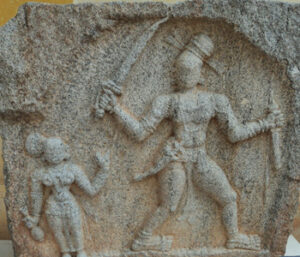GS1 – Art & Culture

- Discovery Context: A 13th-century stone inscription has been unearthed in Krishnagiri district, Tamil Nadu. It marks a significant historical reference to a Buddhist monastery in the region.
- Key Highlights:
- The inscription records a donation by a merchant to a Buddhist Vihara located in Kadaikoottur (modern-day Kadagathur, Tamil Nadu).
- It includes references to “Buddha Devan” and contains depictions of two key Buddhist symbols—the Chakra (Wheel of Dharma) and a Stupa.
- This is the first known epigraphic evidence indicating the presence of a Buddhist monastery in Tamil Nadu.
Anaimangalam Copper Plate Inscriptions
- Significance: These copper plates represent the earliest known record of a Buddhist Vihara in South India.
- Details:
- Issued during the reign of Rajaraja Chola I, they document a land grant of Anaimangalam village to Chudamani Vihara in Nagapattinam.
- The Vihara was constructed by Mara Vijayatunga Varman of the Srivijaya Kingdom in memory of his father, Sri Chudamani Varman.
- Known also as the Leiden Plates, they are currently preserved at Leiden University, Netherlands.
- The charter is bilingual, comprising Sanskrit (used for genealogy and invocations) and Tamil (used for administrative records).
Common Religious Symbols in Inscriptions
| Symbol | Religion | Meaning / Significance |
| Mukkodai | Jainism | Triple umbrella indicating spiritual authority |
| Swastika | Jainism | Represents fourfold existence and auspiciousness |
| Hand-wheel | Jainism | Symbol of non-violence and spiritual discipline |
| Conch | Vaishnavism | Signifies divine sound and creation |
| Chakra | Vaishnavism | Denotes protection and Dharma |
| Shrivatsa | Vaishnavism | Mark of Vishnu, symbol of prosperity |
| Tirusoolam | Shaivism | Shiva’s trident, indicating cosmic power |
| Chakra | Buddhism | Wheel of Dharma symbolizing Buddha’s teachings |
| Stupa | Buddhism | Symbolizes Buddha’s relics and enlightenment |
| Triratna | Buddhism | Represents the Three Jewels: Buddha, Dharma, and Sangha |




